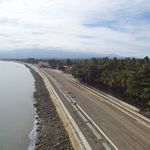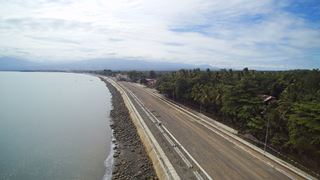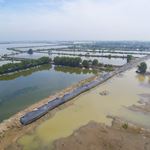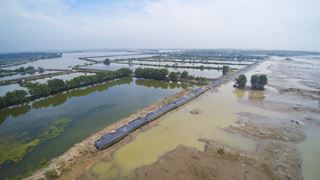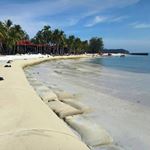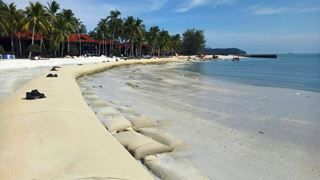Case story
Breakwaters for Shoreline Erosion Protection at Sigandu Beach, Indonesia
Indonesia, North Java
The challenge
Sigandu Beach is located at the North Coast of Java, with an approximate distance of 4 km from the city centre of Batang. Over the past 8 years, the beach has receded by approximately 5m as a consequence of severe coastal erosion problems. This has had an adverse effect on tourism in the area.
The design
To rectify the problem, breakwater designed with TenCate Geotube® system was proposed as a shoreline erosion protection measure by the local government of Batang Regency.
An offshore breakwater is effective in reducing the wave energy approaching the shoreline while intercepting the movement of sediments. Conventionally, breakwaters are constructed using rock armour or concrete structures. With the increasing cost of rock armour due to scarce resources and the rising concerns for the environment, alternative methods are explored including Geotube® systems.
The Geotube® system consists of a primary Geotube® unit that sits on top of a scour apron as shown in Figure 1. Geotube® GT1000ML (9.5m circumference) with a design filled height of 1.5m acts as a breakwater to reduce the wave energy approaching the shore. The length of the tube was 25m. With a non-woven inner liner prefabricated inside the tube, finer fill materials can be used to fill the tube. To prevent the foundation scouring which will result in the instability of the tube, scour aprons Geotube® GT500MSA are installed at the base of the tube. The scour apron consists of a geotextile filter that passes beneath the tube and anchored by two small pilot tubes located at both ends.
The construction
The seabed is first prepared for the installation of Geotube®. Grading is carried out on the seabed to ensure a flat surface prior to the installation of the geotextile tube and any protruding or sharp objects are removed to prevent damage to the geotextile tube. Bamboo poles are then installed at the predetermined locations spaced at ±5.0m alongside the tube to serve as a guide and for restraining the tube location during pumping.
The scour apron is then unrolled on land and floated to the location for installation as shown in Figure 2. Once the location is set, the scour apron is attached to the bamboo poles using ropes tightened to the loops provided along the scour apron for positioning. Subsequently, a sand slurry pump is used to hydraulically pump sand (15%-20% sand ratio) into the pilot tubes of the scour apron through the inlet ports located on top of the pilot tubes. Once the pilot tubes have reached the designed inflated height (0.20m), sand pumping is cut-off and the inlet sleeve is tied to prevent the outflow of sand.
The geotextile tube is then unrolled and floated above the installed scour apron and tied to bamboo poles for the positioning. The filling pipe is then connected to the first inlet port of the tube with all other inlet ports closed except for the last one to allow the overflow of water. Once the tube has reached its designed inflated height (1.5m), the filling pipe is then relocated to other inlet ports to achieve a more even filling throughout the tube. Once the whole tube is fully inflated, all inlet port sleeves are closed and secured in a manner sufficient to prevent movement of the sleeves by wave action.
The performance
The breakwater structure constructed with Geotube® system for Sigandu beach was a cost effective solution as compared to conventional methods such as rock armour. It was successfully installed and is working effectively in protecting Sigandu beach from erosion. The installation of the Geotube® system began in September 2018 and a total of 1.8km length of tubes was installed by the end of 2018.
Completed breakwater
Figure 1. Cross section
Figure 2. Positioning and Pumping



